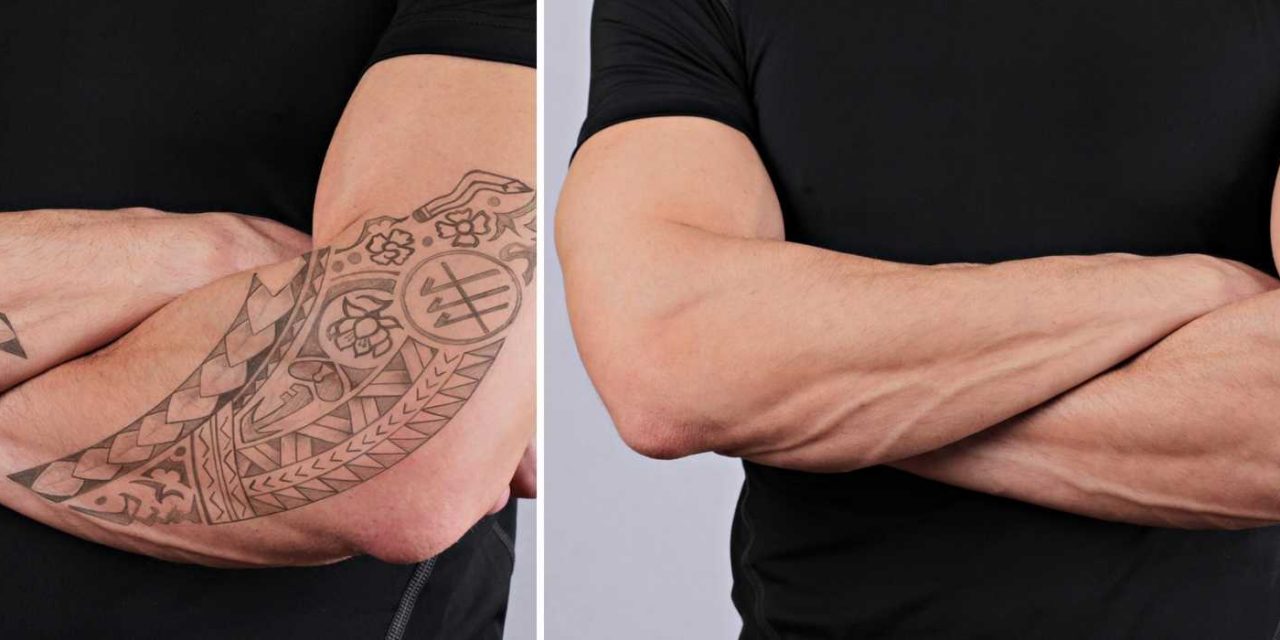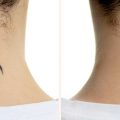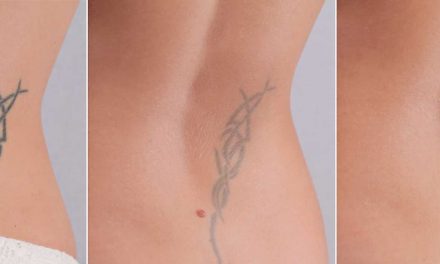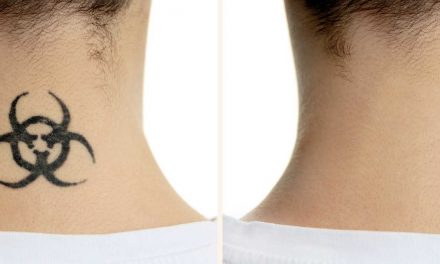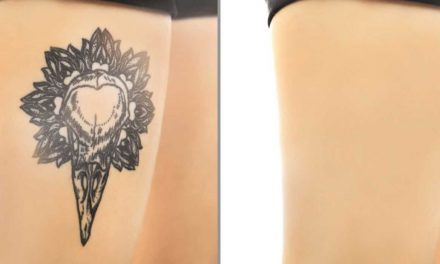Approximately 1 in every 5 adults has a tattoo of some sort. Almost 40% of tattoo wearers are aged 18 to 30, and almost 49% of them are looking to have their tattoos removed using a laser technique.
What Is Laser Tattoo Removal?
There are myriad home and professional methods available for tattoo removal, including laser technique, which we will look at here in more detail.
Selective photo thermolysis (SPTL) is the basis for the success achieved by laser technology in tattoo removal.
This technology allows different colored laser lights to effectively break the colored ink molecules present under the sensitive inner layer of the skin. The fragmented tattoo pigments are then sucked in by the skin, imitating the natural process of fading through exposure to time and the sun.
Lighter colors like green, yellow, and fluorescent shades are harder to break than the darker shades because they are mixed with reflective titanium dioxide. This means that they reflect the laser lights rather than allowing them to penetrate the skin.
The National Institute of Health endorses Q-switched lasers as they cause minimal scarring and have the ability to radiate different lights at separate wavelengths simultaneously.
The amount of energy and the colors required are decided before the start of the treatment and surface anesthesia or cold packs are provided to counter the pain.
While laser tattoo removal may require several sessions before a complete or partial removal of the tattoo is possible, the effects of the treatment could start immediately or during the initial healing period.
Why Do You Need Tattoo Removal by Laser?
Tattoos are the embodiment of personal statements regarding one’s life, another person, choices, thoughts, environment, etc. Once those particular states of thought alter, the need to change or remove the tattoo can becomes important to the individual. Several reasons are quoted at the time of tattoo removal, including age, regret, dislike for the artwork, change in lifestyle, life events, and clothes.
Young people often fail to realise that growing up requires a change in attitude and ideals that could make their current absolutism obsolete in the near future and render the idealistic tattoo a source of embarrassment and regret.
How to Remove Tattoos Using Laser?
The laser’s photomechanical technique is used to break the tattoo molecules.
- First, within a few nanoseconds, the ink components absorb the laser’s energy.
- The ink’s external temperature then rises several thousand degrees, and the energy is immediately converted into shock waves.
- The generated shock wave causes the fragile tattoo molecules, present in the thick sensitive layer of inner skin, to break.
The vibration of the shock waves should not damage the human tissue.
The success of the technique is dependent on four components. First, the specific colors of the laser light must arrive at the tattoo particle present beneath the epidermis.
Second, the requisite laser color needed to break the required tattoo pigment should only be assimilated by the demarked tattoo and not the skin around that area. That is why different colored laser lights are used on different colors of the tattoo, for example, green colored tattoo molecules readily absorb red laser light.
Third, to avoid injuries like burning and scarring, the pulse timing of the laser has to be very quick. The passing of energy that causes the rise in temperature and its eventual conversion to shock waves must be completed in a short interval of time without disturbing the free skin and tissues.
Fourth and lastly, the light energy should be sufficient enough to fragment the tattoo pigment. Anything less would be ineffective.
Therefore, key laser specifications to be kept in mind during the laser tattoo removal include:
- Pulse emission duration or pulse width for tattoo ink removal.
- The breadth of the laser light also known as its spot size also affects the treatment. A bigger spot size helps in effective penetration and hence faster dissolution of the tattoo.
- The density of the energy or its fluency is measured in joules per centimeter square (J/cm2). The energy blast has to be sufficient enough to break the dye particles but not the skin tissues.
Laser Technology
Different colored laser lights are used to remove different colors of the tattoos. They range from discernible light to almost infra-red radiation. Colored tattoos always need multiple laser wavelengths to remove them.
They are segregated based on the lasing mechanism used to generate the laser light measured in nm (nanometers).
- Q-switched Frequency-doubled Nd: Yag: 532 nm laser generates a green light that is easily assimilated by the orange and red colors of tattoo ink. It is also effective in age and sun spot removal because of its high absorption rate of melanin.
- Q-switched Ruby: 694 nm laser produces red light that is effective against green and other dark colors. It can cause skin pigmentation in all skin types except fair skin tone because of its high rate of absorption of melanin. It is recommended for removal of the blue ink intattoos.
- Q-switched Alexandrite: 755 nm is not distinct from the Ruby laser except in its intensity. Since it is weak nature, it is effective on only green colors. It has minimal effect on blue and black and is completely ineffective on orange, red, brown, and yellow. It can be used for frequent penetration though, so it claims to remove ink at a much faster speed than other lasers.
- Q-switched Nd: YAG: 1064 nm is the only laser type that generates rays almost invisible to human eye. This makes it the only type that can be used for tattoo removal from darker skin tones. Its hemoglobin and melanin absorption is also low, making it highly effective on dark colors.
- Separate dye segments are also available that have an ability to alter a 532 nm light to 585 nm wavelength or a 650 nm wavelength, depending on the tattoo color requirement. This is effective in treating smaller tattoos filled with multiple colors, where block treatment is going to prove time and cost consuming.
Laser Tattoo Treatment Sessions
During the consultation, a certified professional would be able to judge the number of sessions required for a successful removal of a tattoo by using the ‘Kirby-Desai Measurement Scale’. Besides the color and the size of the tattoo, a person’s age, the treatment area, and the tattoo type also determines the number of visits. The depth of dye penetration in the skin and patient’s skin color are considered. The sessions are separated by an interval of seven weeks each. This gives the skin the time to absorb the broken down dye particles and to heal. Reducing the time frame only enhances the risk of abrasions and does not enhance the skin’s color pigment absorption rate. The basic principle behind using the laser for tattoo removal is that the laser splits apart the larger tattoo ink particles into small molecules which are absorbed by the skin over time. Thus, the tattoo lightens and then fades out completely over a period of several months.
The Kirby-Desai Measurement Scale
The developers of the scale were dermatologists Dr. Alpesh Desai and Dr. Will Kirby, who specialized in the techniques of tattoo removal. The scale was developed to tabulate the chances of successful treatment and the number of visits required to achieve the final results. The calculations are based on the understanding that the machine used would be Q-switched Nd: YAG and the time interval between treatments would be six weeks.
For computation purposes, number values are assigned to six factors. They include:
- Type of skin
- Location of the tattoo
- Color of tattoo
- Quantity of ink used
- Tissue change or scarring, and
Also, the patient’s immune system plays an important role in the successful removal of the tattoo.
The Orientation Session with the Specialist
During the initial session with the certified laser tattoo removal professional, the patient is assessed for suitability for treatment. After the patient’s eyes are covered by a protective shield. the skin is tested for sensitivity to the laser, and this determines the quantity of energy that the skin can withstand. Using this and the Kirby-Desai barometer, the percentage effectiveness of treatment and its duration is determined and communicated to the patient.
After-Effects of Laser Treatment
Though laser tattoo removal is safe and has very few side effects, it is still in the interest of a potential patient to be aware of them and make their decision accordingly. If post-treatment care is lacking, the treated area could suffer burning and subsequent scarring.
Immediately after the session, the treated area turns slightly white and raised, sometimes accompanied by bleeding. White discoloration happens because of the intense rise in temperature and bleeding is due to vascular injury caused by the shock waves. Any other issues or redness around the surrounding skin is resolved within 24 hours of treatment.
The treated tattoo may develop an outer layer containing melted tattoo particles, which removes itself after a couple of weeks. Because the usage of laser lights as treatment is sterile in nature, usage of antibiotics, in oral and application form, is to be avoided. It can lead to allergies and further complications.
Laser treatment can cause changes in skin pigmentation, but these should revert to normal in a year, depending on the duration of the treatment. Very rarely is the condition permanent. Skin types IV, V, and VI (darker tones) can suffer from hyperpigmentation, but continuous usage of high SPF sunscreen and hydroquinone’s can treat the same over a period of several months.
Superficial change of the skin’s texture is noted only infrequently, but that too should resolve automatically over a period of time, unless the patient suffers from such condition pre-treatment.
As far as possible, the changes in the skin of the treated region should be allowed to heal naturally as using external force could lead to scarring.
Allergies are a more commonly reported side effect, but such incidents can be controlled using anti-allergens and other related steroids.
In some rare instances, tattoos made using white and lightly toned shades, such as pastel pinks, or make-up tattoos, may darken instead of lightening up, and certain colors or tattoo ink may contain a metallic substance which when exposed to laser heat can turn toxic and create varied complications.
Why Should I Select Laser Tattoo Removal Technique
With innumerable people choosing to opt for a change or removal of their tattoos, various methods have been developed. Listed below are some reasons as to why laser technique is the most beneficial method of all.
Approved and Effective
In 2013, the agency gauging the effectiveness and safety of products, the FDA, granted laser tattoo removal technology and approval. Also, compared to other clinical and home-based options, laser technique is much more effective in terms of saving time and achieving the desired results.
Result Driven
Once a licensed practitioner approves of you as a candidate for laser tattoo removal, the method would almost certainly yield desired results.
Approved Medical Care
According to State regulations, a licensed general practitioner is a must at places that do laser tattoo removal procedures. The health professional considers the patient’s medical history before beginning the treatment and is around during and after the conclusion of the treatment to offer proper guidance and care.
More Options
In cases where a person wants to remove just a particular portion of a tattoo, laser treatment is the best option. Laser color lights target specific areas separately instead of working on removing the whole tattoo at the same time, unlike other tattoo removal techniques.
Less Painful
The laser procedure for removing the tattoo is reportedly less painful than getting a tattoo with a needle! The pain is most often described as a lash on the wrist joint by an elastic. Lasers are non-intrusive and are only breaking down the ink components into dissolvable bits, so it is actually the human body that is working towards lightening the tattoo.
Insurance Cover
Tattoos are a matter of personal choice and their removal is a procedure that falls under cosmetic techniques and is therefore unlikely to be covered by insurance. A person should be duly informed of the same before deciding on the procedure and calculating the costs!
More than Laser
Other than a laser tattoo removal procedure, there are other options such as surgical excision and dermabrasion. It is advisable to investigate all the procedures regarding their effects on one’s health, duration of treatment, and cost, etc. before making a final decision.

